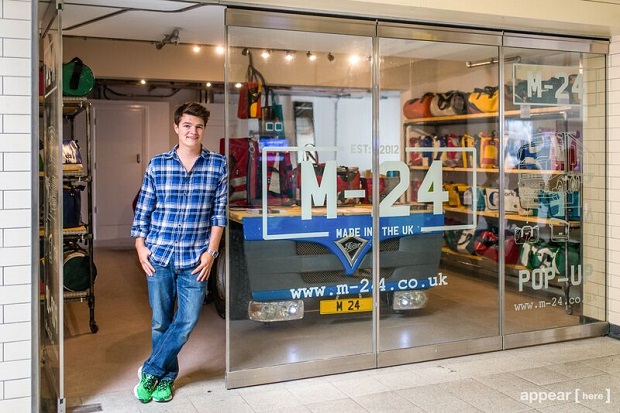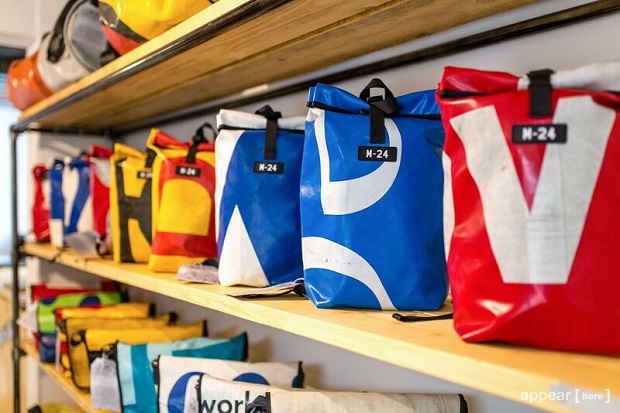Back in 2012, Mat Dusting encountered a well known issue; your bag breaking when you have overloaded it. He was overfilling his bag with sharp objects such as ski’s and snowboards and so decided to design his own. He set about experimenting with different materials such as tarpaulin and sandbags but settled on canvas material. He has found this heavy duty material, made from lorry curtains were strong and waterproof making them perfect for those looking to haul around a lot of luggage.

Mat's products are hand crafted in Somerset and with the nature of the materials, each one is a one of a kind piece. He has now set up a 10 week pop-up shop in Embankment Tube Station to showcase all of his quirky new products which range from tote bags to weekend bags and mac covers to washing bags. We caught up with Mat to find out how it all came about.
Why did you decide to create your bag brand?
I always knew I wanted to start my own business from a young age and after finishing a product design degree I had this idea in the back of my mind to manufacture a sustainable ski bag – perhaps made from recycled materials too.
So after coming back home to the farm in Somerset I started experimenting with materials lying around. This included old sandbags, polythene and canvas. I soon discovered some scrap lorry tarpaulin covering hay bales in the field. This soon led to salvaging them from around the southwest and after doing a bit of research I discovered a huge market place for this type of product.
What makes you stand out in such a competitive market?
All our bags are made from recycled truck tarpaulin that makes them unique in appearance and extremely durable. This combined with our UK manufacturing roots helps separate us from the competition. When you buy a bag from us, it will be a one-off because of the huge variation of truck tarpaulins that we salvage. We work with the best UK manufactures to ensure our bags last years and are thoroughly tested before we release them.
Our focus now is to design and manufacture high quality products but at a competitive price. We can do this by selling direct online to our customers and avoiding the lofty retail mark-ups.

Why have you decided to launch a pop-up shop?
People really understand our products when they can touch and feel them. So after attending a number of successful events we decided to step up it up a level by launching our very own pop-up shop!
We can build up the brand by introducing industrial shelves, tables and cool décor like using a lorry in the shop. I believe it’s a great way of communicating our style, vision and ethos that can’t be replicated online.
Testing and trialing in specific areas of London is also another great benefit of pop-up shops. I’m not committed to long terms leases or hefty business rates, which means I can spend more money on, designing great products, marketing and promotions.
What made you choose Embankment Tube Station?
It’s a great space (53sq meters) right in the center of the capital with over 50,000 people coming in and out of the same turnstiles. So the majority of people will see our shop and if we can capture a tiny percentage of those people then it’s got to be worth doing. In a nutshell the main reasons are:
- High footfall
- Diverse audience
- Easy travel links
- The style of the underground stations fits the style of M-24
- It’s a first in Embankment Station.

Your product is so unique; how will you create the same sort of bespoke vibe in the pop-up shop?
Because our products are so different, it’s difficult to communicate the concept to people in 2 seconds as the walk past the shop. I needed to design a shop that not only looked different but also made it easy for people to understand the concept of recycled truck tarpaulin. So we built a lorry in the shop. I don’t think anyone else has done that?
What challenges have you faced so far when moving into the shop?
The shop was just an empty shell when we moved in so we had to install all the electrics, shelving and lighting. This was quite a challenge but after a few late nights and a few liters of coca cola the whole thing came together. I would recommend moving into a unit with all of these things pre-installed.
Because it’s such a large unit (53 square meters) making it look full was also a potential challenge. I didn’t want lots of bits of furniture scattered around the place because of the cost; logistics and our products might not have the same impact. So I designed big! Which is why we decided to build a fake lorry right in the middle. It’s 6 meters long, 2 meters long and mounted on metal caster wheels so we could just roll the whole thing in.

What advice would you give to someone who is looking to launch a pop-up?
I think it’s important to remember that it’s not just about covering your costs for the unit. Obviously that’s important but not 100% vital. Treat it as an advertising space and a chance to tell your story because online sales will spike, mail subscriptions will spike and word will spread. So if you can over-deliver and create something memorable it will be worth it in the long run.
First impressions last! We’re at embankment station for 10 weeks with the potential to reach over 1 million people during our stay. That’s a lot of first impressions, so it’s important for us to deliver something different. We want people to remember our company long after we leave and tell their friends stuff like “Remember that shop at embankment that had a lorry in it?” They might Google us and rediscover us.
You can find out more about M-24 here